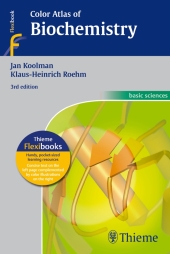 Neuerscheinungen 2012Stand: 2020-01-07 |
Schnellsuche
ISBN/Stichwort/Autor
|
Herderstraße 10
10625 Berlin
Tel.: 030 315 714 16
Fax 030 315 714 14
info@buchspektrum.de |

Jan Koolman, Klaus-Heinrich Röhm
(Beteiligte)
Color Atlas of Biochemistry
3rd ed. 2012. 506 S. w. 211 figs. 190 mm
Verlag/Jahr: THIEME, STUTTGART; THIEME, NEW YORK 2012
ISBN: 1-58890-247-1 (1588902471) / 3-13-100372-3 (3131003723) / 3-13-100373-1 (3131003731)
Neue ISBN: 978-1-58890-247-4 (9781588902474) / 978-3-13-100372-0 (9783131003720) / 978-3-13-100373-7 (9783131003737)
Preis und Lieferzeit: Bitte klicken
Totally revised and expanded, the Color Atlas of Biochemistry presents the fundamentals of human and mammalianbiochemistry on 215 stunning color plates. Alongside a short introduction to chemistry and the "classic topics´´ of biochemistry, the 2nd edition covers new approaches and aspects in biochemistry, such as links between chemical structure and biological function or pathways for information transfer, as well as recent developments and discoveries, such as the structures of many new important molecules.Key features of this title include:The unique combination of highly effective color graphics and comprehensive explanatory texts; Unified color-coding of atoms, coenzymes, chemical classes, and cell organelles that allows quick recognition of all involved systems; Computer graphics provide simulated 3D representation of many important molecules. This Flexibook is ideal for students of medicine and biochemistry and a valuable source of reference for practitioners.
Praise for this book:
Books of this format are rare. Even more so are concise books of this caliber that cover such a wide array of biochemistry-related topics. This is the perfect book for students on the go, or physicians in need of a brief refresher. It provides sufficient Information in its summaries and rich illustrations to gain a basic understanding of any topic it covers. The updated edition is certainly worthwhile as additional areas such as blood clotting and the biochemistry of fatty tissues are now covered. -- Doody Enterprises, Inc.
Providing a powerful visual overview of the entire spectrum of human biochemistry, the third edition of the popular Color Atlas of Biochemistry is an ideal reference and study aid. It utilizes the signature "Flexibook" format, consisting of double-page spreads with clear explanatory text on the left-hand page and exquisitely detailed full-color graphics on the right. These "bite-sized" learning capsules ensure that your review of any given topic is quick, efficient, and comprehensive, allowing you to target the exact information you need for classroom and exam success.
New features of this bestselling review book:
Increased focus on pathobiochemical aspects and clinical correlations, especially useful for exam preparation in the clinical sciences
New and expanded sections on the immune and digestive systems, motor proteins, transport processes, blood clotting and fibrinolysis, biochemistry of fatty tissue, metabolic integration, neurotransmitters and their receptors, signal transduction, and much more!
Symbols for atoms, biomolecules, coenzymes, biochemical processes, and chemical reactions are color-coded to promote quick comprehension
Computer graphics that provide simulated 3D representations of important molecules, making complex subject matter tangible
Convenient color thumb index that guides you quickly through the book
This superb didactic atlas has been used by medical and health science students worldwide since its first publication in German in 1994 and has since been translated into fifteen languages. Its unrivalled illustrations, concise text, and focused presentation all combine to create an excellent, high-yield study guide.
Klaus-Heinrich Röhm lehrt und forscht als Biochemiker am Fachbereich Humanmedizin der Universität Marburg. Nach dem Diplomstudium der Biochemie in Tübingen wechselte er als Doktorand nach Marburg, wo er - von Auslandsaufenthalten abgesehen - bis heute geblieben ist. Seine Arbeitsgebiete sind die Enzyme und der Aminosäure-Stoffwechsel.
Jan Koolman ist Hochschullehrer am Physiologisch-Chemischen Institut der Universität Marburg. Nach dem Studium der Biochemie in Tübingen promovierte er im Fachbereich Chemie und habilitierte sich im Fachbereich Humanmedizin in Marburg. Sein Forschungsgebiet sind die Insektenhormone, sein besonderes Interesse gilt Büchern und Reisen.


